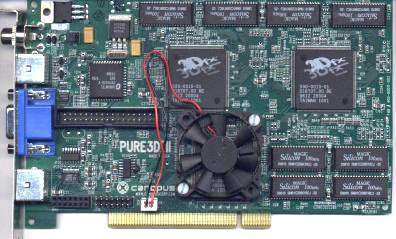Voodoo² Accelerator Review September 1998
Canopus Pure3D 2
The little Canopus card is not based on the 3Dfx reference design. By placing most of the memory on the backside, this PCI card is the shortest PCI Voodoo² accelerator of this review. This could enable it to be placed in baby AT motherboards, where the CPU usually prevents the usage of Voodoo² cards. Canopus also uses a small and very quiet fan to reduce the temperature of the pixelfx² chip; as the default chip clock is 93 MHz, this seems convenient. A little slider has been placed into the options windows to adjust the clock speed between 90 and 100 MHz. Of course, going for 100 MHz is a very touchy affair. I did not get the card running durably stable at 100 MHz inside the midi tower case. 95 MHz seems to be the maximum what you should allow to pass.
The software includes a task bar utility, which can be used as some kind of replacement for the start menu. Other products like e.g. Norton Desktop are more flexible, however I think this is a nice bonus for all the ones that are going to buy the Canopus card.
The loop cable has a proprietary connector for the Pure3D 2 card, similar to a S-video connector. In spite of the cable being relatively thin the picture quality is okay for resolutions up to 1024x768. As with other Voodoo² cards, 1280x1024 becomes a bit blurred.
Last but not least the Canopus card also comes with TV outputs: One composite and one S-video. Of course you may chose between PAL and NTSC mode. The maximum resolution is 800x600, but the card itself does not support higher modes without a daughter board either. If you decide to get the Canopus board you will find the Quake II mission pack "the Reckoning" inside the package.
Get Tom's Hardware's best news and in-depth reviews, straight to your inbox.
Current page: Canopus Pure3D 2
Prev Page Test Setup Next Page The Options Menu Of The Pure3D 2 Software
Patrick Schmid was the editor-in-chief for Tom's Hardware from 2005 to 2006. He wrote numerous articles on a wide range of hardware topics, including storage, CPUs, and system builds.
